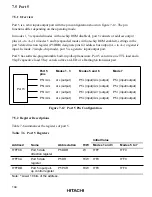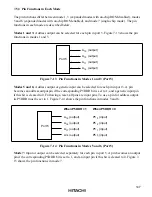
144
7.5 Port 5
7.5.1 Overview
Port 5 is a 4-bit input/output port with the pin configuration shown in figure 7-12. The pin
functions differ depending on the operating mode.
In modes 1, 3 (expanded modes with on-chip ROM disabled), port 5 consists of address output
pins (A
19
to A
16
). In modes 5 and 6 (expanded modes with on-chip ROM enabled), settings in the
port 5 data direction register (P5DDR) designate pins for address bus output (A
19
to A
16
) or generic
input. In mode 7 (single-chip mode), port 5 is a generic input/output port.
Port 5 has software-programmable built-in pull-up transistors. Port 5 can drive one TTL load and a
90-pF capacitive load. They can also drive an LED or a Darlington transistor pair.
Port 5
P5 /A
P5 /A
P5 /A
P5 /A
3
2
1
0
19
18
17
16
A (output)
A (output)
A (output)
A (output)
19
18
17
16
P5 (input)/A (output)
P5 (input)/A (output)
P5 (input)/A (output)
P5 (input)/A (output)
3
2
1
0
Port 5
pins
Modes 1, 3
Modes 5 and 6
P5 (input/output)
P5 (input/output)
P5 (input/output)
P5 (input/output)
3
2
1
0
Mode 7
19
18
17
16
Figure 7-12 Port 5 Pin Configuration
7.5.2 Register Descriptions
Table 7-6 summarizes the registers of port 5.
Table 7-6 Port 5 Registers
Initial Value
Address
*
Name
Abbreviation
R/W
Modes 1 and 3
Modes 5 to 7
H'FFC8
Port 5 data
direction register
P5DDR
W
H'FF
H'F0
H'FFCA
Port 5 data
register
P5DR
R/W
H'F0
H'F0
H'FFDB
Port 5 input pull-
up control register
P5PCR
R/W
H'F0
H'F0
Note:
*
Lower 16 bits of the address.
















































